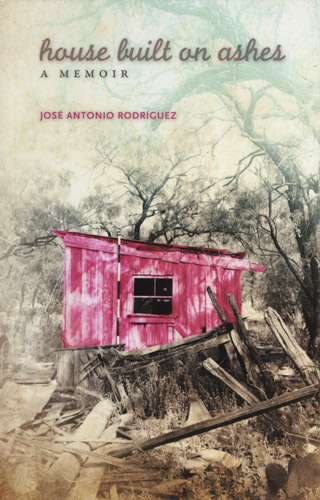House Built on Ashes
There is no doubt that House Built on Ashes by José Antonio Rodríguez is an important story. It focuses on the youngest child of Mexican immigrants, who cross the border frequently to visit family in Mexico but then return to their impoverished life in Texas, where a young Rodríguez confronts issues of poverty, of family uncertainty, bullying at school, and also Rodríguez’s own developing sexuality. The book is organized in vignettes, not a single plot arc, but rather a painting of a life told through one- or two-page essays and narratives, sometimes even bordering on prose poems.
There is no doubt that House Built on Ashes by José Antonio Rodríguez is an important story. It focuses on the youngest child of Mexican immigrants, who cross the border frequently to visit family in Mexico but then return to their impoverished life in Texas, where a young Rodríguez confronts issues of poverty, of family uncertainty, bullying at school, and also Rodríguez’s own developing sexuality. The book is organized in vignettes, not a single plot arc, but rather a painting of a life told through one- or two-page essays and narratives, sometimes even bordering on prose poems. Though the vignettes do sometimes reference each other, they are generally stand-alone, each memory treated individually. These fragments cover a wide range of time—from a six-year-old Rodríguez until his high school graduation, with a few introductory sections from an older perspective—and if there is any sense of “narrative” it comes through the fragments’ chronological order and in their sense of place—the frequent border crossings and the various homes, each slightly better than the one before but always clearly impoverished. These themes of poverty, border crossing, and developing sexuality, all told through the often cruel isolation and misunderstanding of childhood, are stories we can all stand to hear more of, especially as they work to create more empathy for the very people the book is dedicated to, the “the refugee, the unhomed, the exile.”
The individual stories themselves are extremely fascinating. Rodríguez recreates his childhood in language that is poetic and vibrant, even as it is melancholic and often void of understanding. One fragment that haunts me is his description of finding his mother in the kitchen weeping, she offering no explanation for why, and he never revealing if he ever found out. The book is full of such images: no explanation, no adult narrator to step in and ease the tension, just a near-constant river of beautiful, sad images that resolve only because life goes on.
The vignette structure of the book—especially with the locale hopping, the questioning of family dynamics, and the burgeoning understanding of the author’s homosexuality—is a sort of tribute to Mark Doty’s Firebird, which Rodríguez quotes from in the author’s note at the end of the book. Not realizing Doty was a key source from the book until the note at the end, I too was thinking about Doty as I read House Built on Ashes, but mainly for the one small criticism I had of Rodríguez’s handling of his memories. In his essay “Return To Sender,” which is at least partially about the writing of Firebird, Doty gives a metaphor about memory that I find significant:
The past is not static, or ever truly complete; as we age we see from new positions, shifting angles. A therapist friend of mine likes to use the metaphor of the kind of spiral stair that winds up inside a lighthouse. As one moves up that stair, the core at the center doesn’t change, but one continually sees it from another vantage point; if the past is a core of who we are, then our movement in time always brings us into a new relation to that core.
I kept thinking of this quote as I read Rodríguez’s memoir. In the beginning, the youthful narrator’s naiveté is almost cloying as he describes the modern amenities of American suburbs: refrigerators, indoor plumbing, and air conditioning. While the differences in lifestyle on each side of the border is essential to understanding the importance of the memoir, it felt a little heavy-handed. However, what I found more problematic is that the naïve feel of the narration continues as young José ages, so that I often could only tell that we had moved forward in time by being told so. While the continually youthful view is meant, I think, to create a sense of distance from his family and peers, I often kept wondering if the character was really so surprised by American culture, even after having lived at least his school days in it. While I have no doubt that a child’s view of the world is flawed and filled with gaps, I also kept hoping to see where even the young child attempted to fill in those gaps with explanations, not just observances. And though it is clear that the adult narrator’s double perspective is in the arrangement and selection of memories and in the lyric language of the images, I often wished for the reflection and interpretation an adult perspective would have had, perhaps adding more weight to what those memories mean to the writer now.
And though I have made a big deal of that criticism in this review, I didn’t find it disturbing overall in the reading. I was genuinely pleased with the book, often delighted by the lyric language, and touched by the empathy the story called for.





